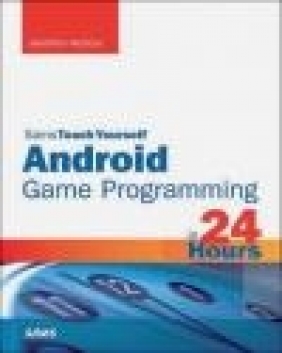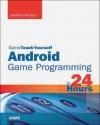Sams Teach Yourself Android Game Programming in 24 Hours
Jonathan Harbour
Sams Teach Yourself Android Game Programming in 24 Hours
Jonathan Harbour
- Producent: Sams Publishing
- Rok produkcji: 2012
- ISBN: 9780672336041
- Ilość stron: 432
- Oprawa: Miękka
Niedostępna
Opis: Sams Teach Yourself Android Game Programming in 24 Hours - Jonathan Harbour
In just 24 sessions of one hour or less, Sams Teach Yourself Android Game Programming in 24 Hours will help you master mobile game development for Android 4. Using a straightforward, step-by-step approach, you'll gain hands-on expertise with the entire process: from getting access to the hardware via the Android SDK to finishing a complete example game. You'll learn to use the Android SDK and open source software to design and build fast, highly playable games for the newest Android smartphones and tablets. Every lesson builds on what you've already learned, giving you a rock-solid foundation for real-world success! Step-by-step instructions carefully walk you through the most common Android game programming tasks. Quizzes and exercises at the end of each chapter help you test your knowledge. By the Way notes present interesting information related to the discussion. Did You Know? tips offer advice or show you easier ways to perform tasks. Watch Out! cautions alert you to possible problems and give you advice on how to avoid them. Jonathan Harbour is a writer and instructor whose love for computers and video games dates back to the Commodore PET and Atari 2600 era. He has a Master's in Information Systems Management. His portfolio site at http://www.jharbour.com includes a discussion forum. He also authored Sams Teach Yourself Windows Phone 7 Game Programming in 24 Hours. His love of science fiction led to the remake of a beloved classic video game with some friends, resulting in Starflight-The Lost Colony (http://www.starflightgame.com). Learn how to...* Install and configure the free development tools, including the Android 4 SDK, Java Development Kit, and Eclipse (or NetBeans) * Use the Android graphics system to bring your game characters to life * Load and manage bitmaps, and use double buffering for better performance * Incorporate timing and animation with threaded game loops * Tap into the touch screen for user input * Learn to use Android sensors such as the accelerometer, gyroscope, compass, light detector, and thermometer * Integrate audio into your games using the media player * Build your own game engine library to simplify gameplay code in your projects * Animate games with sprites using atlas images and fast matrix transforms * Employ object-oriented programming techniques using inheritance and data hiding * Create an advanced animation system to add interesting behaviors to game objects * Detect collisions and simulate realistic movement with trigonometry * Experiment with an evolving engine coding technique that more naturally reflects how games are writtenIntroduction xvii Part I: Introduction HOUR 1: Introducing Android 4 3 Hello, Android 4 3 About the Android SDK 7 About the Android NDK 8 Android Dev System Requirements 8 History of the Platform 9 Android Hardware Specifications 11 Summary 13 Q&A 13 Workshop 14 HOUR 2: Installing the Development Tools 15 Installing the JDK 16 Downloading the NetBeans Package 17 Installing the Package 17 Installing the Android SDK 19 Downloading the SDK 20 Installing the SDK 20 Running the Android SDK Manager 23 Installing the ADT Plug-in for Eclipse 25 Summary 28 Q&A 29 Workshop 29 HOUR 3: Configuring NetBeans and Eclipse with the Android SDK 31 Creating an Android Emulator Device 31 Plugging Android SDK into NetBeans 35 Adding Android SDK Support to Eclipse 40 Summary 45 Q&A 46 Workshop 46 Hour 4: Creating Your First Android Program 47 Creating a New Android Project 47 Building the New Project 52 Editing the "Hello, Android!" Program 60 Comparing the Emulator to an Android Device 63 Summary 72 Q&A 72 Workshop 72 Part II: Android Hardware HOUR 5: Getting Started with Graphics 77 Understanding the Activity Class 77 Testing the Activity States 79 World's Simplest Android Graphics Demo 86 Summary 90 Q&A 91 Workshop 91 HOUR 6: Drawing Basic Shapes and Text 93 Drawing Basic Vector Shapes 93 Drawing Text 99 Writing Code for Javadoc 103 Android Screen Densities and Resolutions 104 Summary 109 Q&A 110 Workshop 110 HOUR 7: Loading and Drawing Images 111 Double-Buffered Drawing 111 Loading a Bitmap File 115 Drawing a Bitmap 120 Summary 126 Q&A 126 Workshop 127 HOUR 8: Bringing Your Game to Life with Looping 129 Creating a Threaded Game Loop 129 Drawing Without onDraw() 132 The Runnable Animation Demo 134 Summary 140 Q&A 141 Workshop. 141 HOUR 9: Multi-Touch User Input 143 Single-Touch Input 143 Multi-Touch Input 148 Summary 155 Q&A 155 Workshop 156 HOUR 10: Using the Accelerometer 157 Android Sensors 157 Summary 168 Q&A 168 Workshop 168 HOUR 11: Using the Linear Acceleration and Proximity Sensors 169 Accessing the Linear Acceleration Sensor 169 Accessing the Proximity Sensor 177 Summary 178 Q&A 178 Workshop 178 HOUR 12: Using the Gravity and Pressure Sensors 181 Using the Gravity Sensor 181 Using the Pressure Sensor 188 Summary 189 Q&A 190 Workshop 190 HOUR 13: Creating Your Own "Tricorder" 191 Encapsulating the Android Sensors 191 Creating the Tricorder Project 195 Summary 211 Q&A 211 Workshop. 211 HOUR 14: Playing with the Audio System 213 Playing Audio Using MediaPlayer 213 Playing Audio Using SoundPool 218 Summary 221 Q&A 221 Workshop 221 Part III: Android Gameplay HOUR 15: Building an Android Game Engine 225 Designing an Android Game Engine 226 Creating an Android Library Project 229 Writing the Core Engine Classes 234 Engine Test Demo Project 247 Summary 253 Q&A 253 Workshop 254 HOUR 16: Creating a Sprite/Actor Class 255 Static Sprite as a "Prop" 255 Dynamic Sprite as an "Actor" 257 Encapsulating Basic Sprite Functionality 258 Testing the Sprite Class 261 Summary 266 Q&A 266 Workshop 267 HOUR 17: Frame Animation Using a Sprite Sheet/Atlas 269 Animating with a Single Strip 269 Animating with a Sprite Sheet (Texture Atlas) 272 The Animation Demo 273 Summary 278 Q&A 279 Workshop 279 HOUR 18: Advanced Multi-Animation Techniques 281 Creating an Animation System 281 Animation System Demo 293 Summary 297 Q&A 297 Workshop 298 HOUR 19: Manipulating Sprites with Matrix Transforms 299 Matrix Translation 299 Matrix Rotation 305 Matrix Scaling 306 Matrix Transforms Demo 307 Summary 319 Q&A 320 Workshop 320 HOUR 20: Entity Grouping 321 Entity Grouping 321 Summary 332 Q&A 332 Workshop 332 HOUR 21: Collision Detection 333 Collision Detection Techniques 333 Demonstrating Collisions 337 Summary 347 Q&A 348 Workshop 348 HOUR 22: Using Linear Velocity for Realistic Movement 349 Calculating Velocity from a Direction 349 "Pointing" a Sprite in the Direction of Movement 352 Enhancing the Engine 355 Summary 368 Q&A 369 Workshop 369 HOUR 23: Scrolling the Background 371 Background Scrolling Overview 371 The Shoot-'Em-Up Game 374 Summary 382 Q&A 382 Workshop. 382 HOUR 24: Ball and Paddle Game 385 Creating the Ball and Paddle Game 385 Summary 394 Q&A 395 Workshop 395 Index 397
Szczegóły: Sams Teach Yourself Android Game Programming in 24 Hours - Jonathan Harbour
Tytuł: Sams Teach Yourself Android Game Programming in 24 Hours
Autor: Jonathan Harbour
Producent: Sams Publishing
ISBN: 9780672336041
Rok produkcji: 2012
Ilość stron: 432
Oprawa: Miękka
Waga: 0.65 kg























